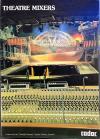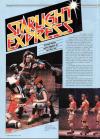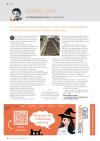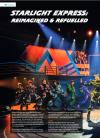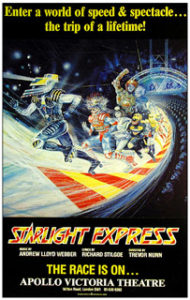
Starlight Express poster (1984 London) from Wikipedia
Music: Andrew Lloyd Webber
Additional Music: Alistair Lloyd Webber
Lyrics: Richard Stilgoe
Additional Lyrics: Don Black, David Yazbek, Nick Coler, Lauren Aquilina
1984 London Credits
Director: Trevor Nunn
Set Design: John Napier
Lighting Design: David Hersey
Choreography: Arlene Phillips
Sound Design: Martin Levan
- Apollo Victoria Theatre, London (27 March 1984 – 12 January 2002) – over 7400 performances
- Gershwin Theatre, New York (March 15 1987 – January 8 1989)
- Japan / Australia Tour (1987) The tour ran from 15 November 1987 to 29 May 1988, a large-scale, in-the-round production that toured sports arenas.
- Starlighthalle, Bochum, Germany (12 June 1988 – present)
- US/Canada Tour 1 (1989) The first US Tour, a downscaled production directly descended from Broadway, ran in the U.S. and Canada from November 1989 – 12 April 1991. The set included a small loop of track into the audience, and the races were pre-recorded film mixed with live action.
- Japan Tour (1990) Starlight Express returned to Japan from 24 March – 18 July 1990 in a revival of the 1987–1988 production.
- Las Vegas (1993) Opened 14 September 1993 in an abridged, 90-minute production without an intermission at the Las Vegas Hilton, where it ran until 30 November 1997. The show required a massive conversion of the theatre, including pouring concrete ramps into the seating area.
- Mexico (1997) From October 1997 until April 1998, a Spanish-language production directed and staged by Bobby Love (after Arlene Philips) played at the Teatro Polanco in Mexico City.
- US Tour On Ice (1997) A completely re-designed production by Feld Entertainment performed Starlight Express on Ice, touring the United States from 6 September 1997 – 1 February 1998.
- US Tour (2003) Following the closure of the London production, Starlight Express: The Third Dimension, a touring production opened in Biloxi, Mississippi. It was a downscaled and shortened version of the show, with further revisions to the material by American composer David Yazbek. Owing to the restrictions of touring theatres, digital video company Inition were commissioned to produce high-definition race footage in 3-D film to replace the live racing.[7] The show ran from 1 April 2003 until 13 June 2004.
- UK Tour (2004) The UK Tour of Starlight Express opened on 4 November 2004 in Manchester. Adapted from the second U.S. tour with some reversions to the “New” London production, including much of David Yazbek’s contribution being removed after Andrew Lloyd Webber saw it performed on stage. In November 2007 the production toured Stockholm, Gothenburg, Oslo and Helsinki, using an expanded set designed for use in stadium venues. The last performance was on March 2008, in Plymouth.
- New Zealand Tour (2009) – Following the end of the UK & Scandinavian tours, the expanded stadium set and properties were shipped to New Zealand to form a new production. Dates in Christchurch, Wellington and Auckland have been confirmed for July/August 2009.
- UK Revival – Troubadour Wembley Park Theatre (8 June 2024 – 16 February 2025)
Related Equipment:
Intellabeam (1990)
MAC 500 Profile (1997)
MAC 2000 Family (2000)
Digital Light Curtain (1991)
MKE2 (1984?)
Quantum 852 (2023)
Documents

Starlight Express Schematic 1 (November 1983)
Click on thumbnail to enlarge
[162kb JPEG]
From Autograph Sound

Starlight Express Schematic 2 (November 1983)
Click on thumbnail to enlarge
[158kb JPEG]
From Autograph Sound

Starlight Express Schematic 3 (November 1983)
Click on thumbnail to enlarge
[141kb JPEG]
From Autograph Sound

Starlight Express Schematic 4 (November 1983)
Click on thumbnail to enlarge
[179kb JPEG]
From Autograph Sound

Starlight Express Schematic 5 (November 1983)
Click on thumbnail to enlarge
[156kb JPEG]
From Autograph Sound

Cadac console at Starlight Express (1984)
Click on thumbnail to enlarge
[377kb JPEG]
From Lighting & Sound International
Video
1984 London Production Additional Credits
Control Panel for Stage Effects by B.J.Steel
Set Constructed and Painted by Kimpton Walker with thanks to William Stoyle and Paul Sadler for their technical assistance.
Bridge Lighting Control by Lucifer
Lighting Equipment and Rigging by Theatre Projects Services Ltd
Sound Equipment and Communications by Autograph Sound Recording
Video Equipment by Mark Huffington of Theatre Projects Services Ltd
Motorised Lighting and Camera Systems by DHA Lighting Ltd and Lightworks
Bridge Constructed by B.T.Skipp
Special Wiring by R.W.S Electrical & Audio Contractors
Additional Notes – Safety Curtain
Due to the train tracks around the auditorium, the safety curtain couldn’t be lowered overnight, so a member of staff had to remain on fire watch overnight.
1987 Broadway Press Reel
The $8 million budget and $2.5 million set transformed the Gershwin Theatre in 1987.
More information about the Broadway show.
Trailer for the German production – Bochum (2007)
2024 London
Troubadour Wembley Park Theatre
Original 1984 Production Information
Set
Design by John Napier
The main components of the London set were a series of race tracks / walkways which extended from the stage out into the stalls, fully enclosing a block of seating, and at a higher level around the edge of the grand circle. Extensive alterations were made to the structure of the Apollo Victoria theatre to accommodate these elements. The audience were thrilled to have actors racing past them on roller skates all around the auditorium.
There was also an early example of stage automation, with a large flown bridge which rotated to connect various tracks and parts of the set together. In addition there were mechanical safety barriers which rose around the tracks in the stalls of the auditorium at ‘race time’.
From the 1988 Souvenir brochure:
Having been a member of the original team that put CATS together, when a production about railway trains with all performers on roller skates was suggested, I realised that we were on a very strange adventure without any of the normal rules that apply to staging a musical. Well, it took only a year and the engineering expertise of some of the best people in Britain.
One of the things said is that Starlight is one of the most expensive musicals in theatre. Well, it is. But also, hopefully when people see it, they will realise not only a lot of money was needed but was well spent on metal work and on finding the right people.
The single most wonderful thing in anyone’s career is to work with a group of people that have a vision of theatre and entertainment. After having done CATS, I regard it as a privilege that they would allow me the indulgence of turning another theatre upside down.
I hope most people will not be too disappointed that there isn’t actually a literal manifestation of a railway train. While attempting to design costumes, I had to bear in mind that people not only had to sing and dance, but had to travel at spectacular speeds around this roller coaster.
The intention in appearance is always to try to get the wit and spirit of the audience to make imaginative leaps from people to trains. It’s taken a year, a lot of stress and strain but ultimately, it was fun.
It used to be said that technical achievements could only happen in America. You’ve seen it here first, and it was only through the expertise of an English work force and technicians that it could have been achieved. To them, I say thank you.
Sound
Design by Martin Levan
See The Evolution of Theatre Sound with Martin Levan and Gareth Owen
Radio microphones were built into the headpieces worn by the actors. 21 mics in total were used. The sound designer, Martin Levan used a large number of speaker cabinets all around the auditorium. This was the debut of Cadac mixing consoles on large West End shows (see Classic Gear article above), and the first time Sennheisers’ MKE2 microphones were used for theatre.
From the 1988 London Souvenir brochure:
Due to the complex control of sound required for Starlight Express a new computer assisted mixing console had to be custom designed and commissioned for the show. New equipment was also designed and built to enable sound to be moved smoothly and quickly around all parts of the theatre. The actors had to learn to use the radio mikes for several weeks prior to opening but there were no problems for the cast when they were moving fast on skates. We had to work closely with Liz Da Costa and the costume department and the mikes have been designed to go into the helmets and wigs. They are the smallest mikes ever to be used in a West End show. Some of the actors did find it difficult wearing transmitter packs if they had not done so before. Andrew Lloyd Webber’s music contains loud dynamic passages and very quiet passages and does demand an extremely high degree o control; therefore the sound system had to be sufficient not to run out of steam.
Music
All of the music for the show was performed by a live band under the stage. The stage extended out over the orchestra pit.

 Starlight Express Cadac Console (1984)
Starlight Express Cadac Console (1984)Custom CADAC mixing console from Starlight Express (1984)
From Autograph Sound

Cadac console at Starlight Express (1984)
Click on thumbnail to enlarge
[377kb JPEG]
From Lighting & Sound International
From Studio Sound, December 1985
The desk has 56 input channels, 32 main and six aux outputs, eight VCA group faders, and a very flexible routing system to accommodate any changes in the production. The inputs are arranged as 22 vocal channels on the L- shaped left hand section of the desk and 26 band channels on the right with eight auxiliary inputs in the middle above the VCA sub groups. Two of the band channels are used to route delayed band sound to speaker systems further forward into the auditorium than the main band speakers. This leaves 24 channels to handle the 15-piece band which comprises: three keyboard players, one with electric piano and Yamaha DX7 synth, one with DX7 and Prophet, one with Prophet and Emulator (all keyboards are DI); one of the keyboard players also plays harmonica on one number (SM77); two woodwind players, one with flute (KM84) and sax (U47), one with clarinet and sax on one mic (C460); six brass players, three trumpets (U89 each), two trombones (U47/Ú89), one French Horn (C414); two guitarists, one bass (DI), one with acoustic guitar (ECM50) and electric guitar (SM77); a drummer with all-electronic kit including bass, snare, hi-hat, toms and cymbals by Simmons and a LinnDrum (all DI); a percussionist with two tympani, tubular bells, snare (2xKM84), congas (MD421), glockenspiel and xylophone (KM86).
You may have counted 16 instrument mies and 13 DI links making a total of 29 sources. This demonstrates a sub-clause of Parkinson’s Law: pit bands expand to fill the space available. A Studer 8/4 mixer was installed on top of the outboard rack alongside the main mixer to handle the overflow. This pre -mixes two trumpets, two trombones and the four percussion mies on to three channels of the main desk.
Alongside each input fader on the Cadac desk is a row of LEDs indicating input level from -20 dB (green) to +20 dB (red). This shows up very quickly if a channel has gone down or is being overdriven. The main input channels have all the usual facilities such as 3-band parametric EQ, aux sends and access to the outboard rack. Each channel can be assigned to one of the VCA groups (1 to 8) for level control or direct (group 0); the selection being indicated by an alphanumeric LED display above the fader. Three VCA groups are allocated to the band: DI keyboards on group 6, all the mies on group 7, DI drums and bass on group 8. The output of the 26 band channels can be directly routed to any or all 16 main outputs via a set of 16 pushbuttons and 16 miniature conductive plastic preset level controls at the top of each channel. Ten of these group outputs exclusively feed the main band loudspeakers which are actually sunk into the back wall of the theatre to maximise the usable stage area. This was quite a major operation involving several pneumatic road drills as there are 10 large speaker systems here, some of them 30 in (762 mm) deep. By selecting the appropriate output routing and adjusting the channel output presets, it is possible to position each of the band sources at any point in the wall of sound across the back of the stage. All the main loudspeakers are from Meyer Sound Laboratories by way of Autograph Sales, British agents for Meyer. The band speakers are four massive MSL-3 and six smaller UPA-1 systems. Each system is biamped and includes a controller with active crossover, delay circuitry to align the phase of the HF and LF drivers, and driver protection limiters to prevent overheating.
The MSL-3 and UPA -1 are not designed to handle very low bass so an 11th output from the desk feeds all the bass instruments to six Meyer USW -1 subwoofers which are arranged round the proscenium arch and are delayed to match in with the main band speakers. The resultant sound is very loud but clean and impressive. Foldback for the band is provided on headphones fed via individual Formula Sound Que -4 mixers so each player can set the desired levels.
Three auxiliary outputs from the main desk carry sections of the band and a fourth feed provides audience reaction which is essential for the conductor. The keyboard players and guitarists each have a feed of their own local output on their fourth channel.
Lighting
Design by David Hersey
Hersey brought the feeling of a rock concert to the West End stage with his groundbreaking high energy design. The Napier-designed bridge featured a rig underneath it to supplement the main rig when it was flown out.
The moving lights on the 1984 version of the show were controlled from an Apple 2E computer.
The lighting design (along with the running order and content of the show) was revised in London in 1992 to refresh it for a new generation.
From the 1988 London souvenir brochure:
The challenge of lighting Starlight Express is to do with movement and scale. The actors cover huge expanses of track in a matter of seconds. A simple lighting idea of the stalls track involves as many as 120 lighting instruments – two or three ideas use as much equipment as many full scale musicals. The sheer complexity of installing all the lighting equipment took a full crew many weeks working day and night.
The object of the exercise was to achieve a lighting rig which could immediately respond to the movement of the set and the skaters and the emotional mood of the music. To this end we developed a system of ‘intelligent’ spotlights which redirect themselves during the evening and undergo some 40 colour change sequences. A ‘normal’ musical will have between 125 and 175 lighting cue states. Starlight has nearly three hundred. We had to stop when the lighting computer’s memory bank was totally full…
Video
An Apple IIe was used to control moving video cameras used to cover the races.
Other Productions
UK Tour
The UK tour in 2005 used 3D projection (as did the previous US tour). The high energy races were pre-filmed, and relayed via 4 digital projectors to a back projection screen flown downstage. More. See also the LSI article above.
German Production – http://www.starlight-express.de/
The Starlighthalle venue in Bochum, Germany was built specially to incorporate racetracks and a large stage area to accommodate this show, in less than a year. Between June 1988 and June 2008 more than 12 million people saw the production.
News
8 June 2001 – Lighting & Sound International
The team behind Starlight Express, now in its 17th year at London’s Apollo Victoria Theatre, have decided to update the show’s lighting rig. After adding High End Intellabeams back in 1993, lighting designer David Hersey and the show’s original production electrician, Howard Eaton, returned this year to update the lighting rig once again. This time they opted to replace the Intellabeams with equipment from Martin Professional.
The Moving Light Company were called upon to supply the production with 24 Martin MAC 500s and three of the new MAC 2000 units. In addition, they supplied two DHA Pitching Digital Light Curtains, which provide a dramatic new way of lighting the spectacular bridge which forms the centrepiece of John Napier’s set design. The changes to the lighting rig were made in a tight 10-day period when the production closed temporarily to allow the auditorium to be re-carpeted and re-seated, during which time Eaton and his team also took the opportunity to upgrade the dimmers and lighting control system, with the rig now controlled by the Rosco-ET Horizon lighting controller.
Horizon programming was in the hands of Robert Bell, one of the creators of the WYSIWYG lighting visualisation software and now Horizon’s product manager, who worked with David Hersey and Howard Eaton to relight the show using the new equipment in a very hectic final three days.
More information



